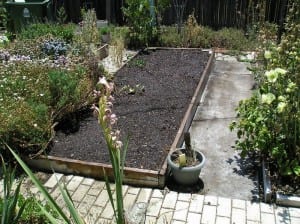Last Updated on March 17, 2025 by teamobn
Summer is becoming more intense every year, to the point that turning on air conditioners all day is a very tempting thought. But that could be very costly for most of us. So how can we survive the summer heat? By making an inexpensive, low electricity air cooler!

Easy homemade air conditioners don’t work as well as the air conditioners we have mounted on our walls, of course. They cannot make an entire room cold, but they provide a cool breeze straight to your direction, enough to make you comfortable throughout the day!
The unit featured in this project was made by a security officer who spends eight hours a day in his truck. Since it isn’t cost effective to have his truck’s air conditioner run all day, he decided to make this portable air conditioner. If you or you know someone who does field work, this is definitely a great DIY project that can help keep automobile expenses low.
If you want this for your home, you can make this unit more suitable by getting a stronger fan, a slightly bigger container (styrofoams will work, too), and by providing two or three vents instead of just one.
This portable homemade air conditioner will provide 2 1/2 to 5 hours of cool air, depending on the temperature of your environment, size of your container and the ice/cooling agents that you use.
Contents
Crafting an Easy Homemade Air Conditioner
Materials:
- Old Cooler
- 12 volt DC Fan
- 4 inch 1/4 Bend PVC Hub
- 4 inch RDR DR 35 PVC Adapter
- 12 Volt DC Accessory Plug
- Piece of Plywood
- Wood Screws
- Ice
Tools:
- Tape Measure
- Saw
- Hole Saw
Steps:

Cut the plywood to fit the inside lip of the cooler. This needs to be a snug fit so you don’t loose air but not too tight as you will have trouble removing it. Cut two holes in the plywood, one for the fan and one for the PVC exhaust.

Cut a 3 inch plywood strip a little bit narrower than the width of the board. Screw this into the bottom of the board. This strip forces the air to go further down into the cooler forcing the air into the ice.

Place the fan over the large hole and drill 4 holes into the fan. Make sure you do not drill into any wires when doing this. You may have to take the fan apart to find the best place to drill. Also make sure the power plug is facing towards the top so you will be able to access it.
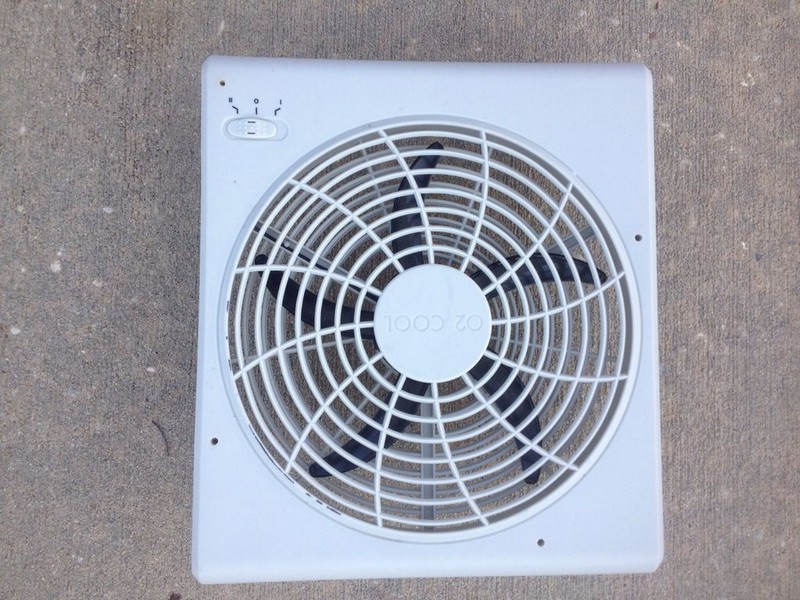
My fan came with a two speed on off switch. The switch was on the opposite side of the power plug. I put the switch on high and mounted the fan switch towards the board. If I want to turn the fan off I just unplug the cord. Screw the fan to the board. Be sure your fan blows into the cooler.

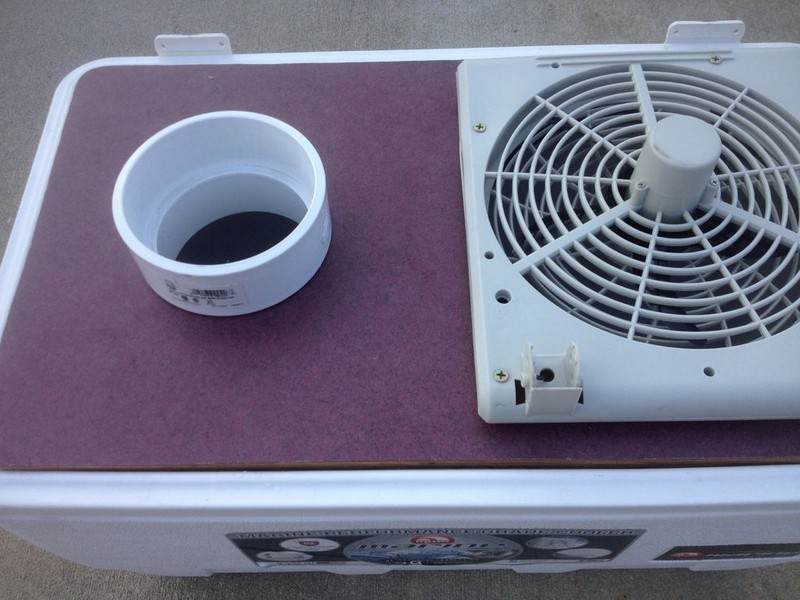
Put the 4 inch PVC adapter into the hole.
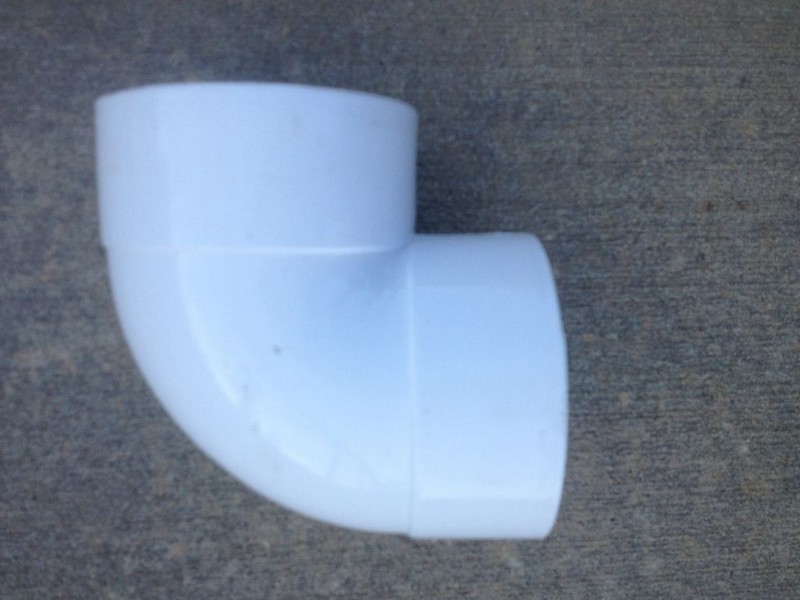
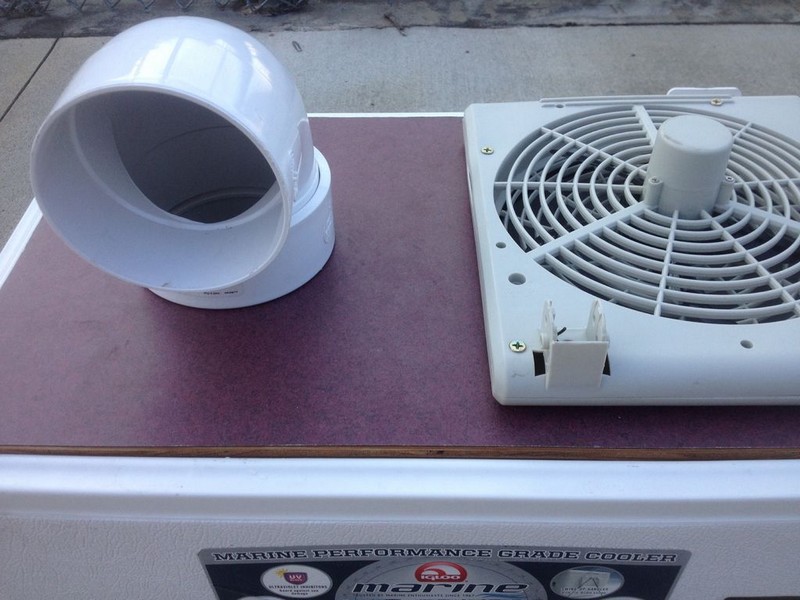
Put the 4 inch 1/4 Bend PVC Hub into the adapter. You should be able to turn the PVC Hub 360 Degrees. This allows you to blow the air in any direction.

Plug your DC Adapter into the fan and the other end into your vehicles 12 volt DC accessory plug. You are now ready to use your Portable Air Conditioner.
Notes: The air will be cooler if you use bag ice, however bag ice will probably melt in about 2 1/2 hours. I freeze water in 1/2 gallon milk jugs. The ice will stay frozen twice as long but the air is not as cool as using bag ice. If you use milk jugs do not fill them up all the way. When water freezes it expands and will burst the milk jugs if they are filled to the top.
Thanks to ROD917 for this great project!
Best Cooling Materials for Easy Homemade Air Conditioners
Making an easy homemade air conditioner is a smart, cost-effective way to stay cool during hot days. But the effectiveness of your DIY cooler depends on the materials you use inside it. The right cooling medium can make a noticeable difference in how long your unit lasts and how cold the air feels. Below are some of the best cooling materials you can use to get the most out of your easy homemade air conditioner.
Bagged Ice
Bagged ice is one of the most accessible and effective cooling materials. You can buy it at almost any convenience store, and it works well because of its large surface area. The more surface area the ice has, the faster it cools the air passing over it. Bagged ice tends to melt in about two to three hours, depending on the outside temperature and your cooler’s insulation. It produces colder air than most alternatives but requires frequent refilling.
Frozen Water Bottles
Freezing water in plastic bottles is a popular option for those using an easy homemade air conditioner. Bottles are less messy since they don’t produce water runoff, and they’re reusable. They last longer than loose ice—often double the time—but they won’t make the air as cold. Leaving a little space at the top before freezing prevents the bottles from cracking due to ice expansion.
Frozen Saltwater Bottles
Adding salt to the water lowers its freezing point. This means saltwater bottles stay colder longer, making them a great choice for an extended cooling session. The downside is that if the bottle leaks or cracks, you’ll have saltwater to deal with, so it’s best to double-check for leaks before freezing.
Reusable Ice Packs
Gel-based reusable ice packs are convenient, especially if you already have them in your freezer. They’re compact and typically stay cold for a reasonable amount of time. However, they often don’t cover as much surface area as ice or frozen bottles, which can limit airflow cooling.
Dry Ice
Dry ice offers the coldest temperatures among all options. It evaporates without leaving a liquid mess and can cool air rapidly. However, it needs to be handled with care. Always use gloves and ensure proper ventilation when using dry ice in your cooler. It’s not suitable for enclosed spaces because of the carbon dioxide gas it releases.
Frozen Sponges
Soaking sponges in water and freezing them is an easy and inexpensive method. The frozen sponge provides cold air and minimizes water runoff since it reabsorbs the meltwater. It’s a simple, low-cost option for small easy homemade air conditioner setups.
Choosing the right cooling material for your easy homemade air conditioner depends on your needs. If you want colder air for a short time, bagged ice or dry ice works well. If you need longer-lasting cooling with less mess, frozen bottles or ice packs are ideal. Experiment with these options to find what works best for you and stay comfortable through the heat.

How to Improve the Efficiency of Your Easy Homemade Air Conditioner
An easy homemade air conditioner is a great solution when you need relief from the heat without running up your electricity bill. While these DIY units are simple and cost-effective, their cooling power can be limited. The good news is, with a few small upgrades and smart techniques, you can get even better performance out of your homemade cooler. Whether you use yours in a vehicle, on a patio, or in a small room, improving its efficiency means cooler air that lasts longer. Here’s how you can make the most of your easy homemade air conditioner.
Use a Well-Insulated Container
The container you use plays a big role in how effective your homemade air conditioner will be. A standard plastic cooler works, but a well-insulated cooler holds cold temperatures much longer. If you can, choose a container with thick insulation like a high-quality camping cooler. Some DIYers use Styrofoam boxes, which are lightweight and insulating but not as durable. A good container reduces how quickly the ice melts, giving you hours of cool air.
Seal Any Gaps
Cold air can easily escape through small gaps and cracks in your air conditioner’s structure. Sealing those gaps keeps more of the cold air inside the unit, which improves efficiency. You can use weather stripping, foam tape, or even duct tape to seal around the lid, the fan, and the air vent fittings. Check for any loose areas where air might leak and make sure the lid fits snugly. The tighter the seals, the colder your airflow will be.
Choose the Right Cooling Material
What you put inside your cooler matters. If you’re looking for longer-lasting cooling, frozen water bottles or frozen saltwater bottles are great options. They stay frozen longer than bagged ice and create less mess. If you want colder air for a shorter time, bagged ice or dry ice will give you stronger cooling. For maximum efficiency, fill the cooler with as much ice or frozen material as possible. The more cooling material inside, the longer your easy homemade air conditioner will stay cold.
Direct the Airflow Properly
The placement and direction of your vents matter more than you think. Position the air outlet where you need it most—whether that’s at your desk, in your car seat, or towards your bed. You can improve airflow by using adjustable vents or a movable PVC elbow. Some people attach a flexible dryer vent hose to aim the cool air in specific directions. Efficient airflow ensures you’re getting the most out of the chilled air your cooler produces.
Use a Powerful and Efficient Fan
The fan you choose can make or break your easy homemade air conditioner. A stronger fan moves more air, which helps push cold air out of the cooler and into your space. However, it also consumes more power, so balance is key. Look for an energy-efficient DC fan with adjustable speeds. If you’re using the cooler indoors and have access to power, a small electric box fan can work even better. For battery or solar-powered setups, focus on low-power fans that still move a decent volume of air.
Pre-Chill the Cooler
Before you load your cooler with ice or frozen bottles, pre-chill it. You can do this by placing ice inside the container for 30 minutes before you set up the full unit. A cold container will slow the melting process once you start using your homemade air conditioner. This small step helps maximize cooling efficiency from the start.
Keep It Out of Direct Sunlight
Heat from direct sunlight speeds up the melting of your ice and warms up your cooler. Place your easy homemade air conditioner in a shaded area or indoors to reduce heat gain. You can even wrap the cooler in a reflective material like an emergency blanket to reflect sunlight and keep the temperature inside lower.
Add Ventilation Holes Strategically
Too few vents can limit airflow, while too many can waste cold air. One or two well-placed ventilation holes are usually enough for a basic unit. Ensure your fan is positioned to pull in warm air from the outside and force it over the ice, pushing the cold air out through your vent. Experiment with different hole sizes to get the airflow just right.
Use Larger Ice Blocks
Small pieces of ice melt quickly. Large ice blocks or frozen gallon jugs melt more slowly and last longer. If you don’t have a mold, you can freeze water in large containers like milk jugs or juice cartons. Larger ice blocks give you a more stable cooling effect over time, especially if your easy homemade air conditioner runs for several hours.
With a few smart improvements, your easy homemade air conditioner can be even more efficient. Focus on better insulation, sealing gaps, choosing the right cooling materials, and optimizing airflow. These small upgrades can make a big difference in how cool you stay and how long your DIY air conditioner runs. Whether you use it at home, in your car, or outdoors, a little extra effort goes a long way in beating the heat.
Conclusion
A sensible and reasonably priced approach to keep cool in hot weather is building an easy homemade air conditioner. Small areas or outdoor use would be ideal for a portable cooling system created with the correct materials and a few basic steps. This low-cost approach lets you cool off without running costly, energy-hungry appliances.
We have more “cool” ideas to keep cool during the summer. Check out our rustic cooler project next!






